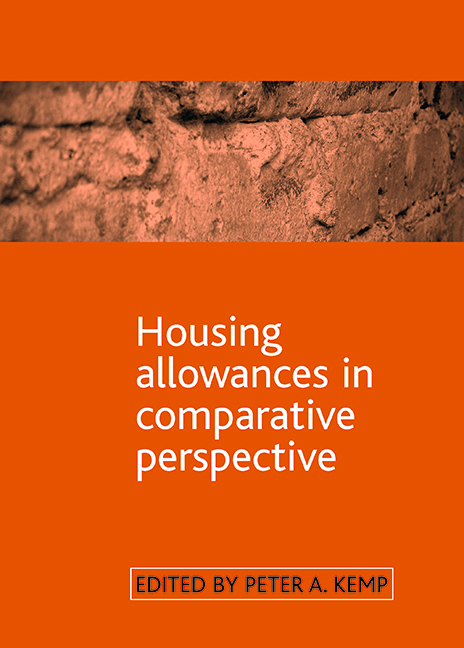Book contents
- Frontmatter
- Contents
- List of tables and figures
- Acknowledgements
- Notes on contributors
- one Housing allowances in context
- two Housing allowances and the restructuring of the Australian welfare state
- three The New Zealand experience of housing allowances
- four Canadian housing allowances
- five Housing allowances American style: the Housing Choice Voucher programme
- six Housing Benefit in Britain: a troubled history and uncertain future
- seven Housing allowances in France
- eight Housing allowances in Germany
- nine Housing allowances in the Netherlands: the struggle for budgetary controllability
- ten Housing allowance systems in Sweden
- eleven Housing allowances in the Czech Republic in comparative perspective
- twelve Housing allowances in the advanced welfare states
- Index
three - The New Zealand experience of housing allowances
Published online by Cambridge University Press: 15 September 2022
- Frontmatter
- Contents
- List of tables and figures
- Acknowledgements
- Notes on contributors
- one Housing allowances in context
- two Housing allowances and the restructuring of the Australian welfare state
- three The New Zealand experience of housing allowances
- four Canadian housing allowances
- five Housing allowances American style: the Housing Choice Voucher programme
- six Housing Benefit in Britain: a troubled history and uncertain future
- seven Housing allowances in France
- eight Housing allowances in Germany
- nine Housing allowances in the Netherlands: the struggle for budgetary controllability
- ten Housing allowance systems in Sweden
- eleven Housing allowances in the Czech Republic in comparative perspective
- twelve Housing allowances in the advanced welfare states
- Index
Summary
Introduction
Understanding the development of housing allowances within a particular nation state requires a historical perspective and a consideration of the way in which allowances are linked to state policy and practice. Further, current policy instruments arise out of both past decisions made and contemporary debates and understandings (Lowe, 2005). The history of New Zealand housing policy since the 1950s shows it has gone through a number of stages. This chapter tracks these changes to illustrate the changing position of housing allowances and their place within the overall housing policies of successive governments.
Housing allowances in context
In the 1950s and 1960s, the dominant thrust of public policy was to extend homeownership. The belief that underlay this policy was that a home-owning society was a more stable and prosperous one. Also, as this was a time of strong population growth and inward migration, there was a need to encourage the growth of the housing stock. Thus, much of the emphasis in housing policy was around increasing the housing supply. In the 1950s and 1960s, governments were active in both land development and providing a range of supports for first-time buyers to acquire housing, with this being targeted to the purchase of new housing. This policy mix provided a range of assistance that included the capitalisation of family benefit, a weekly cash allowance for each child, which could be used as a deposit and the provision of low-interest loans to modest- and low-income earners from the State Advances Corporation. In 1974, these loans were transferred to the Housing Corporation of New Zealand. The corporation was a multifunctional entity created to manage state stock, assist in the purchase of housing through the operation of lower-interest rate mortgages, to provide policy advice, and to undertake research with respect to housing affairs. The policies at this time with respect to homeownership were complemented by the provision of state social rented housing. However, the amount of such housing has always been relatively small and only briefly did this sector achieve 9% of the total tenure.
The welfare regime in place in New Zealand, from the 1930s to the 1980s, has been characterised as a wage earners welfare state (Castles, 1985).
- Type
- Chapter
- Information
- Housing Allowances in Comparative Perspective , pp. 39 - 60Publisher: Bristol University PressPrint publication year: 2007



